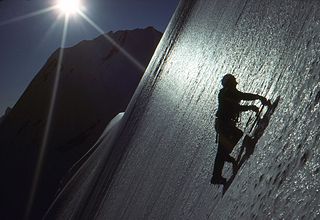
Action sports, adventure sports or extreme sports are activities perceived as involving a high degree of risk. These activities often involve speed, height, a high level of physical exertion and highly specialized gear. Extreme tourism overlaps with extreme sport. The two share the same main attraction, "adrenaline rush" caused by an element of risk, and differ mostly in the degree of engagement and professionalism.
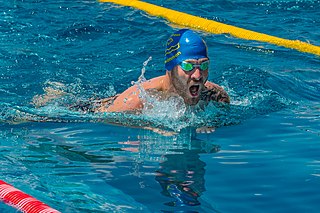
Swimming is the self-propulsion of a person through water, or other liquid, usually for recreation, sport, exercise, or survival. Locomotion is achieved through coordinated movement of the limbs and the body to achieve hydrodynamic thrust that results in directional motion. Humans can hold their breath underwater and undertake rudimentary locomotive swimming within weeks of birth, as a survival response. Swimming requires stamina, skills, and proper technique.

Water skiing is a surface water sport in which an individual is pulled behind a boat or a cable ski installation over a body of water, skimming the surface on two skis or one ski. The sport requires sufficient area on a stretch of water, one or two skis, a tow boat with tow rope, two or three people, and a personal flotation device. In addition, the skier must have adequate upper and lower body strength, muscular endurance, and good balance.
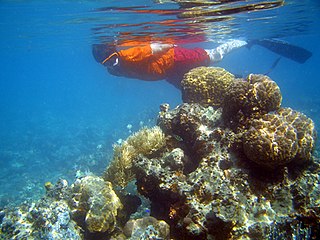
Snorkeling is the practice of swimming face down on or through a body of water while breathing the ambient air through a shaped tube called a snorkel, usually with swimming goggles or a diving mask, and swimfins. In cooler waters, a wetsuit may also be worn. The snorkel may be an independent item or integrated with the mask. The use of this equipment allows the snorkeler to observe the underwater environment for extended periods with relatively little effort, and to breathe while face-down at the surface.

A wetsuit is a garment worn to provide thermal protection while wet. It is usually made of foamed neoprene, and is worn by surfers, divers, windsurfers, canoeists, and others engaged in water sports and other activities in or on water. Its purpose is to provide thermal insulation and protection from abrasion, ultraviolet exposure, and stings from marine organisms. It also contributes extra buoyancy. The insulation properties of neoprene foam depend mainly on bubbles of gas enclosed within the material, which reduce its ability to conduct heat. The bubbles also give the wetsuit a low density, providing buoyancy in water.

Canyoning is a sport that combines several outdoor sports like rock climbing, hiking, swimming, and rappelling. A canyoneer travels down canyons using a variety of techniques that may include other outdoor activities such as walking, scrambling, climbing, jumping, abseiling (rappelling), and swimming.

Recreational diving or sport diving is diving for the purpose of leisure and enjoyment, usually when using scuba equipment. The term "recreational diving" may also be used in contradistinction to "technical diving", a more demanding aspect of recreational diving which requires more training and experience to develop the competence to reliably manage more complex equipment in the more hazardous conditions associated with the disciplines. Breath-hold diving for recreation also fits into the broader scope of the term, but this article covers the commonly used meaning of scuba diving for recreational purposes, where the diver is not constrained from making a direct near-vertical ascent to the surface at any point during the dive, and risk is considered low.
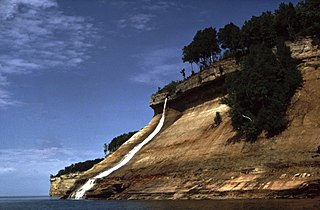
Pictured Rocks National Lakeshore is a U.S. National Lakeshore in the Upper Peninsula of Michigan, United States. It extends for 42 mi (68 km) along the shore of Lake Superior and covers 73,236 acres. The park has extensive views of the hilly shoreline between Munising and Grand Marais in Alger County, with picturesque rock formations, waterfalls, and sand dunes.

Rock climbing is a sport in which participants climb up, across, or down natural rock formations or indoor climbing walls. The goal is to reach the summit of a formation or the endpoint of a usually pre-defined route without falling. Rock climbing is a physically and mentally demanding sport, one that often tests a climber's strength, endurance, agility and balance along with mental control. Knowledge of proper climbing techniques and the use of specialized climbing equipment is crucial for the safe completion of routes.

Dancing Ledge is part of the Jurassic Coast near Langton Matravers in the Isle of Purbeck in Dorset, England. Dancing Ledge is a flat area of rock at the base of a small cliff. A little scrambling is required for access. It is signposted on the South West Coast Path a few kilometres west of Swanage. Dancing Ledge is so called because at certain stages of the tide when the waves wash over the horizontal surface, the surface undulations cause the water to bob about making the ledge appear to dance.

Cliff jumping is the leaping off a cliff edge, usually into a body of water, as a form of sport. It may be done as part of the sport of coastal exploration or as a standalone activity. Particular variations on cliff jumping may specify the angle of entry into the water or the inclusion or exclusion of human-made platforms or other equipment. Cliff diving and its close relative tombstoning are specific to water landing. Cliff jumping with the use of a parachute would typically be classified as a form of BASE jumping.
River climbing, river trekking, river tracing or mountain stream climbing is a form of hiking or outdoor adventure activity, a traditional sport in Japan and popular in Hong Kong and Taiwan, and, in some ways, similar to canyoning or canyoneering. River trekking is a combination of trekking and climbing and sometimes swimming along the river. It involves particular techniques like rock climbing, climbing on wet surfaces, understanding the geographical features of river and valleys, knotting, dealing with sudden bad weather and finding out possible exits from the river.

The Quincy Quarries is a 22-acre (8.9 ha) public recreation area in Quincy, Massachusetts, commemorating the site of the Granite Railway—often credited as being the first railroad in the United States. The former quarries produced granite for over a century, leaving problematic excavations that ultimately were taken over and filled in to protect public safety. The reservation is owned and operated by the Massachusetts Department of Conservation and Recreation.
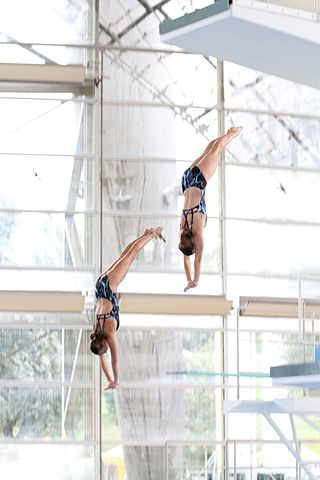
High diving is the act of diving into water from relatively great heights. High diving can be performed as an adventure sport, as a performance stunt, or competitively during sporting events.

A swim brief or racing brief is any briefs-style male swimsuit such as those worn in competitive swimming, diving and water polo. The popularity of the Australian Speedo brand racing brief has led to the use of its name in many countries around the world to refer to any racing brief, regardless of the maker. Occasionally, the speedo genericized trademark is applied to square cut swimsuits, but in general the generic term is used in reference to swimming briefs. Swim briefs are also referred to as competition briefs, swimming trunks, bathers, togs, racer bathers, posing briefs, racing briefs, and colloquially in Australia, New Zealand, and the United Kingdom as budgie smugglers.

Outdoor recreation or outdoor activity refers to recreation done outside, most commonly in natural settings. The activities that encompass outdoor recreation vary depending on the physical environment they are being carried out in. These activities can include fishing, hunting, backpacking, walking and horseback riding — and can be completed individually or collectively. Outdoor recreation is a broad concept that encompasses a varying range of activities and landscapes.
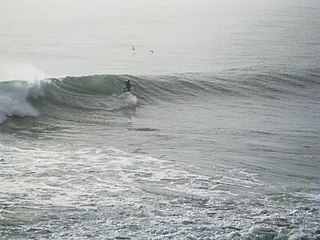
Chile has many beaches for surfing, especially in the northern region where the weather conditions attract many surfers from all over the world. Except for the winter months surfing is possible all year. The water temperature ranges from 15 to 20 °C. Although the waves in central Chile are bigger, the waves in the north are stronger and are usually better suited for surfing. The cold waters of central and southern Chile can be brutal to surf, therefore, surfers adventuring into those areas are strongly advised on using a protective wetsuit to protect against the elements.
The Search and Rescue Squad is the Search and Rescue unit of Victoria Police and provides specialist expertise, advice and practical assistance in land search and rescue. This expertise covers most terrains including snow and vertical cliff search and rescue.
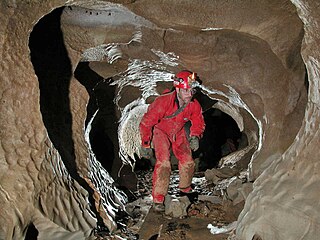
Caving equipment is equipment used by cavers and speleologists to aid and protect them while exploring caves. The term may also be used to refer to equipment used to document caves, such as photographic and surveying equipment. Originally, cave diving equipment was quite limited, but the increasing popularity of caving during the 20th century led to the creation of specialist caving equipment and companies.
Seatrekking is a sport that consists in exploring the shorelines of oceans, seas, bays, lakes or rivers both above and below the water over the course of several days, without the aid of a boat or a watercraft. Seatrekking involves swimming, snorkeling, freediving and hiking, and combines all these disciplines into a distinctive form of sport and outdoor experience. Unlike coasteering, seatrekking includes overnight camping and involves trips of longer distances.

















